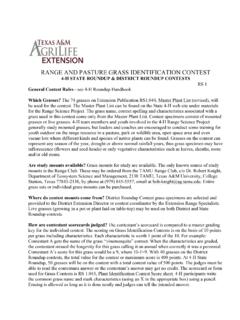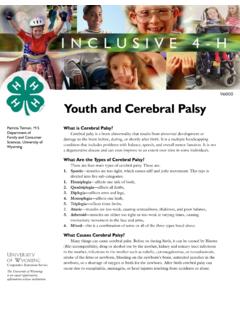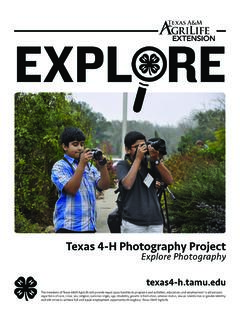Transcription of Texas 4-H Rabbit Project
1 Texas 4-H Rabbit ProjectShowing RabbitsThe members of Texas A&M AgriLife will provide equal opportunities in programs and activities, education, and employment to all persons regardless of race, color, sex, religion, national origin, age, disability, genetic information, veteran status, sexual orientation or gender identity and will strive to achieve full and equal employment opportunity throughout Texas A&M 4-H youth Development | 4-H Rabbit PROJECTD escriptionThe Texas 4-H Explore series allows 4-H volunteers, educators, members, and youth who may be interested in learning more about 4-H to try some fun and hands-on learning experiences in a particular Project or activity area.
2 Each guide features information about important aspects of the 4-H program, and its goal of teaching young people life skills through hands-on experiences. Additionally, each guide contains at least six learning experiences, which can be used as a Project guide, or as activities for six different 4-H 4-H is designed to develop the youth of our state into productive adult citizens. The 4-H Program uses a non-formal educational process of engaging youth in a learning by doing process. This includes hands-on opportunities, participation in workshops and clinics conducted by volunteer leaders or professionals, as well as competitive experiences which allow 4-H members to demonstrate the knowledge they have gained.
3 Through this entire process, the youth are learning key life skills such as working with others, teamwork, cooperation, and goal setting. Through all experiences, youth get to interact with adult volunteers and county Extension is 4-H?4-H members across the nation are responding to challenges every day in their communities and their the youth development program of the Cooperative Extension System of land-grant universities, 4-H is the nation s largest youth development organization, empowering six million young people throughout the United States.
4 Cooperative Extension of 1862 and 1890 land-grant universities provide leadership to engage young people in 4-H in all 3,007 counties of the United States. The impact of the Cooperative Extension partnership is profound, bringing together National Institute of Food and Agriculture of USDA, land grant universities and county government to resource learning opportunities for America s 110 land-grant universities and its Cooperative Extension System, 4-H reaches every corner of our nation from urban neighborhoods to suburban schoolyards to rural farming communities.
5 With a network of more than 6 million youth , 600,000 volunteers, 3,500 professionals, and more than 25 million alumni, 4-H helps shape youth to move our country and the world forward in ways that no other youth organization 4-HTexas 4-H is like a club for kids and teens ages 5-18, and it s BIG! It s the largest youth development program in Texas with more than 550,000 youth involved each year. No matter where you live or what you like to do, Texas 4-H has something that lets you be a better you!You may think 4-H is only for your friends with animals, but it s so much more!
6 You can do activities like shooting sports, food science, healthy living, robotics, fashion, and for 4-H clubs at your school, an after-school program, a community center, or even on a military base or through the reserves for military 4-H is part of the Texas A&M AgriLife Extension Service and the Texas A&M System. Founded in 1908, 4-H is the largest youth development program in Texas , reaching more than 550,000 youth each 4-H Motto and Pledge To Make the Best Better! I pledge: My HEAD to clearer thinking, My HEART to greater loyalty, My HANDS to larger service and My HEALTH to better living, For my Club, my Community, my Country, and my in 4-H4-H is a great program because it provides options for young people to participate.
7 From a 4-H club located in your community, a SPIN club that focuses on one particular Project area, or participating in 4-H through your classroom at school, 4-H allows youth to learn in many different environments. If you are interested in joining 4-H, contact your County Extension Office and ask for a list of the 4-H clubs in your area. If you are a school teacher/educator and would like to use 4-H curriculum or these Project guides in your classroom, contact your Extension Office as well for 4-H youth Development | Learning by Doing Learning ApproachThe Do, Reflect, Apply learning approach allows youth to experience the learning process with minimal guidance from adults.
8 This allows for discovery by youth that may not take place with exact do with limited how to describe results of the experience and their relate the experience to the learning objectives (life skills and/or subject matter). youth connect the discussion to the larger use the skills learned in other parts of their THE CONTENTI ntroduction of the topic, overview and exploration of content, and review of objectivesBuild on knowledge by learning more and advancing to the another topic/levelTexas 4-H youth Development | Project4-H Rabbit PROJECTL essonsLesson 1 Getting Started, Things to Think About.
9 2 Lesson 2 Market vs. Breeding, Which One is for Me? .. 5 Lesson 3 Bringing Your Animals Home ..13 Lesson 4 Caring for Your Rabbits ..15 Lesson 5 Show Time! ..19 Lesson 6 Show Follow Up ..21 Developed by:Megan LoganSketch byGarry BranhamTexas 4-H youth Development | 24-H Rabbit PROJECTL essonsGetting Started, Things to Think AboutTIME:30 to 45 minutesMATERIALS NEEDED: Handout of questions for each participant Pens/pencils for each participantOBJECTIVES: The 4-H member will: Identify skills learned through the Rabbit Project . Decide if the Project is the right one for THE CONTENT: Why the Rabbit Project ?
10 A Rabbit Project is a great way to get started with an animal science Project . Rabbits do not require a lot of fancy or expensive housing or equipment, which makes them one of the more affordable animal projects to begin your animal science experience. Many times youth who are living in an urban area are not able to have an animal Project , but since rabbits are housed in hutches, they are great for urban and rural settings. The Rabbit Project will provide you with opportunities to learn and practice a number of skills including: Communication Decision Making Leadership Patience Record Keeping Responsibility Understanding and concern for living creaturesOther experiences you will have while participating in the Rabbit Project include: Learning how to care for and raise your rabbits Learning about animal behavior, animal science, nutrition, as well as health and disease control Sharing and learning from other members of your 4-H clubDO.






